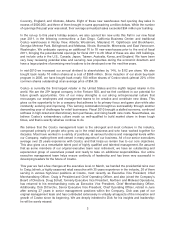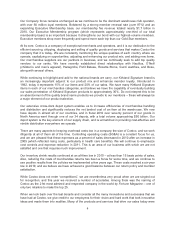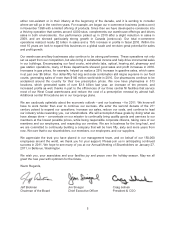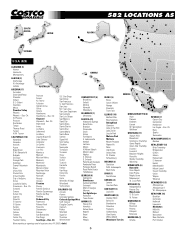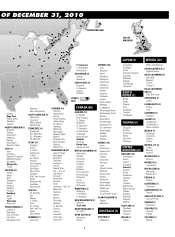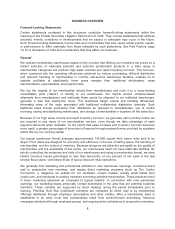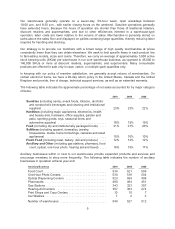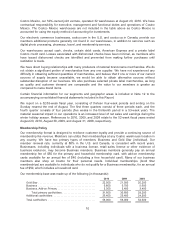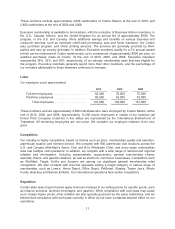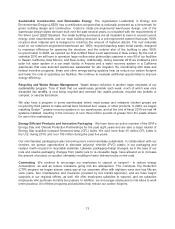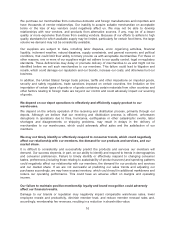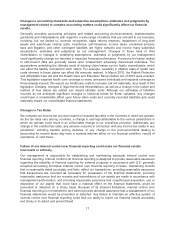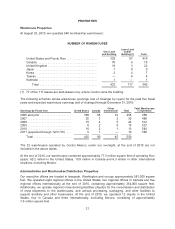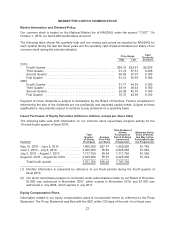Costco 2010 Annual Report Download - page 15
Download and view the complete annual report
Please find page 15 of the 2010 Costco annual report below. You can navigate through the pages in the report by either clicking on the pages listed below, or by using the keyword search tool below to find specific information within the annual report.Sustainable Construction and Renewable Energy The organization Leadership in Energy and
Environmental Design (LEED) has a certification program that is nationally accepted as a benchmark for
green building design and construction. Costco’s metal pre-engineered warehouse design, one of the
warehouse design styles we have built over the past several years, is consistent with the requirements of
the Silver Level LEED Standard. Our metal building envelopes are all insulated to meet or exceed current
energy code requirements, and our main building structure is a pre-engineered system that uses 100%
recycled steel material and is designed to minimize the amount of material utilized. The roof materials
used on our metal pre-engineered warehouse are 100% recycled standing seam metal panels, designed
to maximize efficiency for spanning the structure; and the exterior skin of the building is also 100%
recycled metal. In 2008, we opened our first certified Silver Level warehouse in New Jersey. By the end of
calendar 2010 we will have in operation large rooftop solar photovoltaic systems in over 50 of our facilities
in Hawaii, California, New Mexico, and New Jersey. Additionally, during calendar 2010 we installed a pilot
solar hot water system in a car wash facility in Arizona and a water recovery system in a California
warehouse that uses selected warehouse wastewater for site irrigation. By coordinating with state and
federal incentive programs, these and other energy-saving systems help us reduce our carbon footprint
and lower the cost of operating our facilities. We continue to evaluate additional opportunities to improve
energy efficiency.
Recycling and Waste Stream Management Waste stream reduction is another major emphasis of our
sustainability program. Tons of trash that our warehouses generate each week, much of which was once
discarded into landfills, is now being recycled and renewed into usable products, recycled into biofuels or
compost, or used as feed stock.
We also have a program in some warehouses where meat scraps and rotisserie chicken grease are
recycled by third parties to make animal feed, biodiesel fuel, soaps, or other products. In 2009, we began
installing Goslyn™grease recovery systems in our warehouses, and at the end of fiscal 2010 we had 94
systems installed, resulting in the recovery of over three million pounds of grease from the waste stream
for use in the marketplace.
Energy Efficient Products and Innovative Packaging We have been an active member of the EPA’s
Energy Star and Climate Protection Partnerships for the past eight years and are also a major retailer of
Energy Star qualified compact florescent lamp (CFL) bulbs. We sold more than 35 million CFL bulbs in
the U.S. during 2010, and over 159 million during the past five years.
Our merchandise packaging is also becoming more environmentally sustainable. In collaboration with our
vendors, we pursue opportunities to eliminate polyvinyl chloride (PVC) plastic in our packaging and
replace it with recycled or recyclable materials. Likewise, packaging design changes, as in the case of our
nuts and snacks packaging changes from plastic jars to re-closeable bags, have allowed us to increase
the amount of product on a pallet, ultimately resulting in fewer delivery trucks on the road.
Commuting We continue to encourage our employees to carpool or vanpool - to reduce energy
consumption, as well as reduce emissions going into the atmosphere. The Commute Trip Reduction
(CTR) program we began sixteen years ago at our corporate office with eighteen vans now has fifty-six
vans (vans, fuel, maintenance and insurance provided by five transit agencies); and we have begun
vanpools in our regional offices, as well. We offer employees subsidies to vanpool, and we subsidize
employees who purchase monthly bus passes. In addition, we encourage employees to ride bikes to work
when practical. All of these programs and activities help reduce our carbon footprint.
13


